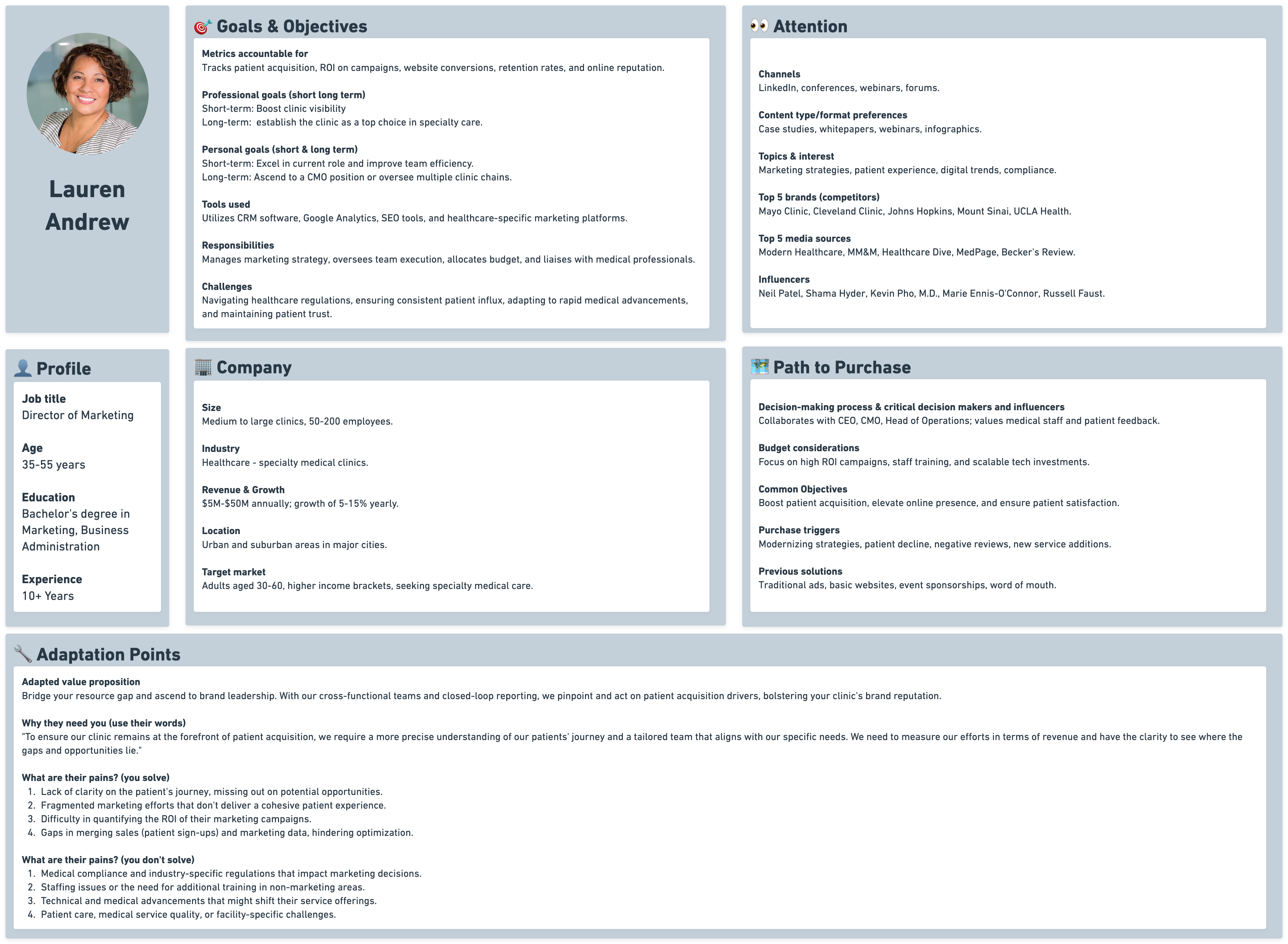
What is an Ideal Customer Profile (ICP)?
In the marketing world, you need clarity to stand out. The first step to getting that clarity? Knowing your Ideal Customer Profile.
So, what's an Ideal Customer Profile (ICP)? It's like a detailed sketch of your dream customer. It describes the kind of company or person that would really benefit from what you offer. Think of them as your best match in business. They're not just buying from you. They'll love your brand, interact with what you share, and might even shout about you to others.
When creating your ICP, avoid being too general. Great marketing is in the details. Look closely, ask questions, and check your guesses. The clearer and more on-point your ICP is, the better you'll connect with the right folks.
Why ICPs are Important
The success and money your company makes is directly linked to how well you know your customers. It's like this: the better you know the group of people most likely to buy from you – your niche – the more successful you'll be. It's tempting to try and reach everyone, but often, focusing on a specific group brings better results. This is because when you truly understand your Ideal Customer Profile, everything clicks. Your messages stand out, more people buy, and your whole business just works better.
Components of an ICP
Getting to know your Ideal Customer Profile (ICP) isn’t a cookie-cutter process. Every business is different, so the questions you'll need to figure out your ICP will vary. But to give you an idea, here's a common example of a B2B ICP template that many businesses use:
Download our free Whimisical template here.

Profile
- Job title
- Age:
- Gender
- Education
- Experience
Goals & Objectives
- Metrics accountable for
- Professional goals (short long term)
- Personal goals (short & long term)
- Tools used
- Responsibilities
- Challenges
Attention
- Channels
- Content type/format preferences
- Topics & interest
- Top 5 brands (competitors)
- Top 5 media sources
- Influencers
Path To Purchase
- Decision-making process & critical decision makers and influencers
- Budget considerations
- Common Objectives
- Purchase triggers
- Previous solutions
Company
- Size
- Industry
- Revenue & Growth
- Location
- Target market
Adaptation Points
- Adapted value proposition
- Why they need you (use their words)
- What are their pains? (you solve)
- What are their pains? (you don't solve)
We focus a lot on using digital ways to grow demand. That's why our ICP template looks at where our customers spend their time online. It's not just about getting our message out there but making sure it connects with our audience where they're most active.
The key element here? Grasping your customer's 'adaption points'. While the core of what you offer remains unchanged, the way you present it adapts based on a profound understanding of your ICP. When you truly comprehend your customers’ aspirations, needs, and pain points, you can mold your messaging to seamlessly align with their context. This is about more than just adjusting your pitch—it's about resonating at an emotional level.
Remember, customers often make decisions driven by emotions rather than just facts. By aligning your approach to their emotional landscape, you foster a much deeper and more impactful connection.
How to Use Ideal Customer Profiles
Your Ideal Customer Profile (ICP) is more than just a theory—it's a roadmap to supercharge different parts of your business.
Marketing Strategy
With your ICP in hand, you know exactly where to find your best customers. Instead of guessing, target the specific things they care about—like job titles, tools they use, or where they hang out online. This makes your marketing efforts more accurate. Also, by knowing what other brands or influencers they like, you can position your brand to stand out in a crowded market.
Copywriting
When you speak directly to your ICP's interests and worries, your words have more impact. Forget vague messages. Address their real-world concerns, dreams, and challenges. This personalized approach can transform everything from ads and emails to landing pages, making your audience feel truly seen and heard.
Sales
Your sales team will love the ICP! With a clear idea of the perfect customer, they can focus on reaching out to the people most likely to say 'yes'. This means better leads and more sales. No more shooting in the dark.
A/B Testing
You've made smart guesses with your ICP, but you need real-world feedback. A/B testing lets you test out different strategies to see what truly clicks with your audience. Keep refining and testing to make sure your approach is as effective as possible.
How to Research Your ICP
Finding out more about your Ideal Customer Profile (ICP) requires a mix of number-crunching and real-world conversations.
Quantitative Research
1. Amazon: One of the world's largest marketplaces is also a goldmine for insights. Identify books that align with topics pertinent to your ICP. Delve into the reviews for a deeper understanding:
- Positive Reviews: Understand what resonated with readers, what they found invaluable, and the key takeaways they mentioned.
- Negative Reviews: Discern the gaps in content, what readers felt was lacking, or what they desired but did not find.
- Note: You can automate the scraping of these reviews and use generative AI to quickly organize and spot these trends.
2. Google Trends: This tool provides insights into what's currently popular or rising in interest in your domain, helping pinpoint areas of focus.
3. Keyword Tools: Platforms like UberSuggest and SEMrush's Keyword Magic Tool can provide insights into what terms and topics your ICP is searching for, offering a direct window into their interests and needs.
4. Your Customer Database: Analyze the data you've already accumulated. Look for commonalities, trends, or patterns that can shed light on your ICP's characteristics and behaviors.
5. Google Analytics: Delve into metrics related to user behavior, demographics, and acquisition channels. This can provide a rich tapestry of information on where your ICP originates from and how they interact with your content.
6. Survey Data: Direct feedback from your audience can offer invaluable insights. Analyzing survey results can pinpoint specific needs, desires, and challenges.
7. SEMrush Market Data: The Market Explorer tool provides a holistic view of the market, helping to identify dominant players, emerging trends, and potential opportunities.
Qualitative Research
1. Personal Experience: Sometimes, the best insights come from your own experiences. Reflect on interactions, feedback, and past experiences related to your domain.
2. Interviews: Engage directly with potential or existing customers. Deep, one-on-one conversations can unearth nuances that quantitative data might miss.
3. Participant Observations: By immersing yourself in environments or settings that your ICP frequents, you can gain firsthand knowledge of their behaviors, challenges, and aspirations. This observational method allows for a more empathetic understanding, bridging the gap between data and real-world applications.
How to Decide Which ICP to Focus On
Choosing an Ideal Customer Profile (ICP) is like setting a GPS destination—it provides direction, but it doesn't mean you can't change course along the way. It's essential to remember that focusing on a specific customer profile now doesn't limit future possibilities. As with any journey, there can be detours, new routes, and exciting discoveries.
Given the ever-changing nature of business landscapes and customer preferences, flexibility is crucial. So, how do you determine the right ICP for your current journey?

Utilize Market Frameworks: Frameworks provide a systematic approach to break down and identifying your audience, ensuring your resources are optimally allocated:
- TAM (Total Addressable Market): This is the big picture. TAM represents everyone who might benefit from what you're offering. It encompasses all the people or businesses confronted with the challenges your product or service seeks to resolve.
- SAM (Serviceable Addressable Market): This is a more focused view. SAM is the segment of TAM that you can realistically target and serve. These are the individuals or entities not only facing the problems you solve but are also within your reach and are likely to be receptive to your solution.
- ICP (Target Market): Here's your core audience. The ICP is that subset within the SAM that aligns perfectly with your product's value proposition. These are the customers who'll get the most out of what you offer, championing your brand and facilitating its growth.
Learn from Your Current Customers: Your current customers are like a gold mine of information. By looking closely at them, you can uncover which ICP deserves more of your focus. Here's how to do that:
- Personal Fulfillment: Think about the customers you love working with. Do you feel a sense of achievement with certain segments? Strong relationships and mutual interests can lead to long-lasting business ties.
- Value Perception: Notice which groups truly see the worth in what you bring to the table. If they see the value, they're more likely to stick around and invest more.
- Profitability: It's all about the numbers too. Check which customer groups are bringing in the most money. It might not always be about high revenue; sometimes, it's the profit margins that matter.
- Win Rate and Churn: Track your successes. Which groups do you 'win' more often? And from which groups do fewer customers leave (churn)? The ideal ICPs are where you have more wins and fewer losses.
- Customer Satisfaction: Happy customers are a big clue. If a segment consistently gives positive feedback, it shows you're hitting the mark with them.
- Growth Opportunities: Try to project ahead. Which customer segments look promising for the future? Think about potential growth and how you might expand in these areas.
- Decision-making Power: Make sure you're talking to the decision-makers. It's efficient and more fruitful to engage with those who have the power to say 'yes' to your offerings.
Summary
In the vast expanse of the business world, possessing a keen understanding of your market is fundamental—a truth encapsulated in the term "marketing" itself. The purpose of your Ideal Customer Profile (ICP) stretches beyond mere identification of potential customers. It serves as a compass, guiding you to those who seamlessly align with what you offer. Recognizing the inherent emotional nature of human decisions, a meticulously crafted ICP allows you to connect beyond just the tangibles. It's about echoing their aspirations, acknowledging their challenges, and resonating with their deepest sentiments. This profound emotional rapport, achieved through an apt ICP, stands as a cornerstone for enduring success. We vouch for its efficacy from our own experiences and wholeheartedly recommend its adoption to others. We've found immense value in this approach and urge you to experiment with this powerful tool.
 Brandon Wentland
Brandon Wentland